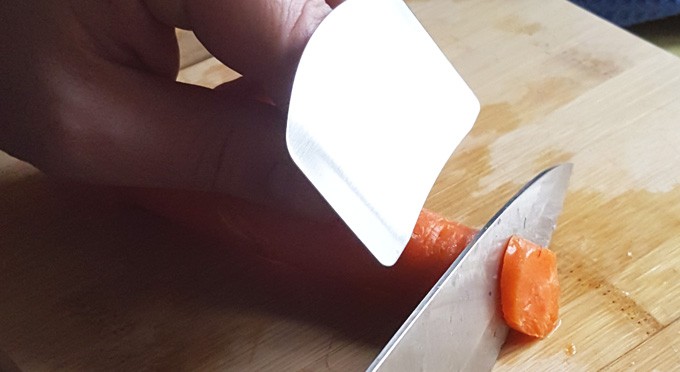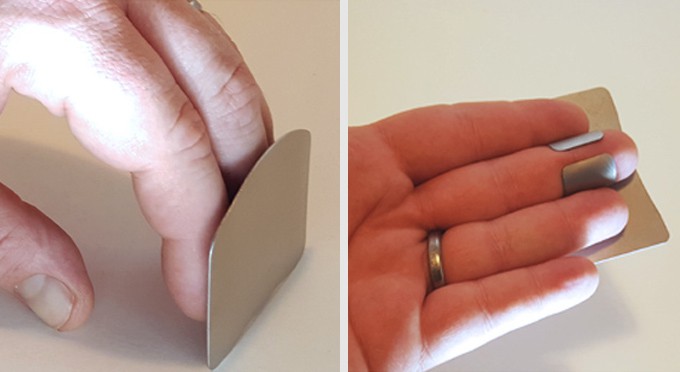
Your fingers look nice still attached to your hand. Let’s keep them that way.
Prepping food like a professional chef can be an intimidating activity, and it’s one that many of us avoid due to the inherent risk of injury. You know that all of those scary knives are just waiting for the chance to “accidentally” slice you when you’re not looking, so you avoid using a knife altogether.
You may be inexperienced, out of practice, extra clumsy, or just especially accident prone, and as a result, those razor sharp blades can pose a real risk to your health. Before you give up hope, or start prepping all of your food with an electric processor, you may want to try a little protection so you no longer have to fear the blade. With a knife guard in place, the dangerous edge is unable to touch your skin, so you never have to worry about unexpected abrasions or severed digits.
Protect Your Fingers While Chopping and Slicing
Our Safe Slice Knife Guard is a simple and clever device that slips over your fingers to create a protective barrier between your delicate skin and the knife you’re using. It acts like a little shield to protect your hand, and prevent any possibility of injury.
The back side features an adjustable metal band that secures the guard to your hand, and it easily adapts to remain tight on any size hand. Because the knife guard can be worn on any finger, and rotated to any angle, it also works well with any type of food, and with any grip you prefer. The open design allows you to hold the item being cut comfortably, and the overall design ensures that it won’t get in the way, or force you to work in a way that’s uncomfortable.
Once in place, the large shield at the front will guard against accidental injury by blocking any unwanted pokes or slices. Wearing this guard when slicing food will give any novice the confidence of a pro because accidents will be virtually impossible.

How To Use It
Slip the Safe Slice Knife Guard onto your hand anytime you prepare food for instant piece of mind. The extra layer of safety it provides will help you increase cutting speed, improve your slicing accuracy, and allow you to attempt techniques that are more risky. Your food prep will take less time, the results will be better, and you’ll never have to worry about running to the emergency room, or dashing to get a box of band-aids. You may have to explain to others what the heck is on your hand, but after you explain it, they’ll be asking where you got it.
- Always wash fruits and vegetables prior to slicing.
- Once clean, place atop a cutting board or another safe surface.
- Take your non-dominant hand and slip on the Safe Slice. Ensure that the finger band is tight around your finger.
- Wear on index or middle finger, and rotate to accommodate the position of your food.
- Grip the food you are cutting and allow the knife guard to form a wall between your hand and the knife blade.
- Take your knife in your dominant hand, and proceed to slice like normal.
- Cut all the way up to the guard without worry, and slowly move back to reveal more uncut food.
- Dishwasher safe when finished.
Your kids like carrot sticks, and whole tomatoes just aren’t the same on top of a cheeseburger. It’s perfectly sane to fear large blades that are incredibly sharp, especially when questionable people like ourselves are wielding them. Get this simple little gadget and never say no at snack time again, or embarrass yourself trying to cut veggies with a butter knife. Use this safety guard to give yourself the confidence that comes with knowing that you will never cut your finger, no matter how many potatoes and onions you chop.
Other Ways To Avoid Accidents When Using a Knife in The Kitchen
Chopping and slicing food by hand can be perfectly safe if you follow proper safety practices, and use care at all times. It’s easy to avoid cuts when you have a thick shield in the way of the blade, but here are some other tips to prevent accidents when using a sharp knife in the kitchen:
- Always Use the Sharpest Knife Possible: Contrary to what you might think, a sharp knife is safer than a dull one. A sharp knife requires less force to cut through food, reducing the risk of slipping and losing control.
- Choose the Right Knife: Select the appropriate knife for the task at hand. Different knives are designed for specific purposes, so use the right tool for the job.
- Secure Your Cutting Surface: Ensure your cutting board is stable and won’t slip or move while you’re chopping. Use a non-slip cutting board or place a damp kitchen towel or a piece of non-slip shelf liner underneath.
- Maintain Proper Hand Placement: Use the “claw” grip when holding the food you’re chopping. Curl your fingertips under and rest the knuckles against the blade of the knife. This keeps your fingers out of the way and provides stability.
- Cut Away from Your Body: Always cut away from your body to avoid accidentally cutting yourself. Keep your non-cutting hand and fingers well clear of the knife’s path.
- Maintain Control At All Times: Maintain full control of the knife by using a fluid rocking or slicing motion. Avoid hacking or using excessive force, as this can lead to accidents.
- Pay Close Attention: Stay focused on the task at hand and avoid distractions. Don’t rush, and take your time when chopping to ensure accuracy and safety.
- Steady Cutting Motion: Maintain a steady, rhythmic chopping motion. Inconsistent chopping can lead to accidents.
- Use a Cutting Glove: Consider wearing a cut-resistant glove on your non-cutting hand, especially if you’re new to using sharp knives or feel unsure about your knife skills.
- Maintain Knife Care: Keep your knives clean and well-maintained. Dull or damaged knives can be more dangerous as they require more force to cut through food.
- Store Knives Safely: When not in use, store your knives in a knife block, magnetic strip, or blade guards to protect the blade and prevent accidents.
- Teach and Supervise: If you have children in the kitchen, teach them knife safety and supervise their use of knives until they are old enough and skilled enough to use them independently.
- Handle with Care: Always pass knives to others handle-first and place them on the counter with the blade away from the edge.
- Use a Proper Cutting Technique: Learn proper cutting techniques for different foods. For example, use a rocking motion for herbs and a slicing motion for vegetables.
- Use a Cutting Board with a Groove: A cutting board with a groove around the edges can catch juices and prevent them from spilling onto the counter, reducing slip hazards.
By following these safety practices and respecting the sharpness of your knives, you can significantly reduce the risk of accidents while chopping in the kitchen.